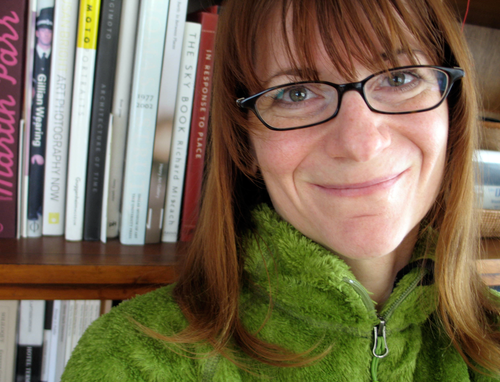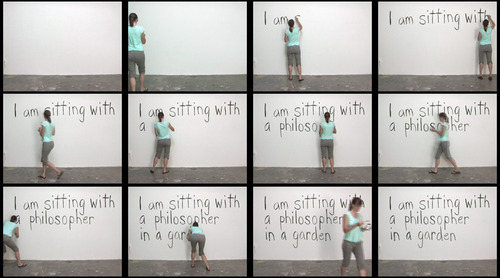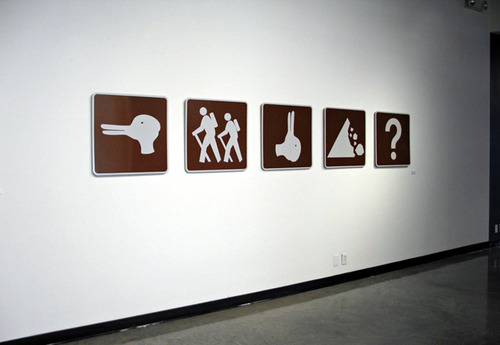
A couple years ago, a friend introduced me to the work of conceptual artist Jan Estep. But instead of calling her a conceptual artist, my friend referred to her, just as accurately, as an Artistphilosopherpoet.
While, like other conceptual artists, her primary medium is ideas—which she communicates through sculpture, photography, video, sound installation, and writing—her work is uncommonly integrated; it addresses not only the mind but body and spirit, and is as likely to utilize humor as obscure philosophical reference—and often employs both at once.
She holds a PhD in philosophy and an MFA in visual art. She was an editor for the New Art Examiner before becoming a professor in the art department at the University of Minnesota. Much of her work can be accessed through her website, www.janestep.com. Two current projects include a Buddhist meditation installation at the Minneapolis Institute of Arts and a collaborative project with neuroscientists investigating the relationship between imaging and data.
We discussed meeting up to conduct this interview in person, but it was twenty below in Minneapolis, and we decided email would work just fine.
—Scott F. Parker
I. IN WHICH WITTGENSTEIN IS NOT DISCUSSED
THE BELIEVER: Before going to grad school in art you studied with William Gass for your PhD in philosophy. How did he influence your movement between academics and art?
JAN ESTEP: It was total luck to have Gass on the philosophy faculty at Washington University, to study and TA for his lecture classes. He absolutely loves language, the feel of it in the body, the play of it conceptually, the tour de force of a writer’s thinking laid bare on the page. He gave permission to find pleasure in thinking and writing, permission not to produce academic prose but find some alternate means. The more eclectic graduate students in the department gravitated to him as their dissertation advisor, those who didn’t quite fit in. Having him there was a real-life example of what was possible: finding a home within academia but violating, successfully, the disciplinary writerly conventions of the field. He also, bless him, read every single word of my dissertation drafts, much of which was too personal and had to be removed, without shaming me for letting my mind do whatever it needed en route to the final public version. I was very shy then and too intimidated to have a grown-up relationship with him personally, but I got just the right amount of support and encouragement to continue and to trust the value of my own mind. He was the only faculty member who knew I was secretly painting in my basement while working on my dissertation, the only one I believed would understand having dual interests. Combining rigorous intellectual investigation with an equally robust creative imagination.
BLVR: Why did you leave academic philosophy to pursue art?
JE: I suspected that academic philosophy wouldn’t be the best fit for me creatively. It was hard for me to choose a specialty and narrow my territory. And then writing the dissertation was incredibly painful. Somehow I let myself consider another option, despite having set up a perfectly good career in philosophy. I did teach full-time in the field after I got the degree, but ultimately I trusted my sense that art would be more accommodating.
I also strongly felt that I needed to get my body back. So much energy had been devoted to cultivating my intellect, to testing its capabilities, but for me this meant that other faculties atrophied. Art was a way to check the over-intellectualization and return to my material embodied experience: to explore the world through my senses, and somehow integrate this information with a life of the mind.
I continued to teach philosophy, however, while I pursued art. I am drawn to the way philosophers think and the questions they ask, even if I don’t want to produce or publish in the field.
II. IN WHICH WITTGENSTEIN FEATURES PROMINENTLY
BLVR: And your work reflects this. Wittgenstein in particular seems to be an important influence for you. Your On Certainty, which borrows its title from Wittgenstein, shows you painting one of the philosopher’s jokes in time-lapse. In another project, you incorporate the rabbit/duck image he popularized. And of course Searching for Ludwig Wittgenstein has you traveling to his Norwegian cabin. What draws you to Wittgenstein?
JE: Other than the existentialist literature of Camus and Sartre, the first book I read in philosophy was Wittgenstein’s Tractatus Logico-Philosophicus, where he basically establishes the relationship of language to the world and the limits of the sayable. Most of the text was over my head—it’s written in a difficult style of numbered, logically embedded propositions—but even in my flawed understanding it had a profound impact. I was so naïve: I had never thought of the problem of language, of certainty, of other minds, of what cannot be known or said. Really, it was a transformational book, and the notion that an ordinary human being could and in fact should consider these things was inspirational. From that moment on language has been a recurring interest of mine, the utter contradiction that words are so infinite yet so limited, they foster yet abrade communication.
I’m also drawn to Wittgenstein’s story, the way he quit philosophy and later returned, the way he revisited and radically revised his earlier thinking, his reclusiveness and social awkwardness, his fierce intelligence and confidence. The fact he respected ordinary language and for the most part steered away from technical jargon yet maintained a level of thought that was not at all dumbed down. I don’t fully understand the affinity but much of it has to do with reading him at the right time in my life, to open up a whole new world of thinking activity that struck a nerve in me.
BLVR: What is the process through which something like the Wittgenstein Project grows out of that background?
JE: Wittgenstein is so clear: he targets a conceptual conundrum and poses specific thought experiments to help us understand his point, to test the truth of what he’s saying with our own mental thinking-though. I think art can do that too. Although I rely on the openness of images, I say a lot in my artwork: literally, by incorporating words and voiceover narrative. I find myself going to texts by Wittgenstein whenever I’m thinking about language. My On Certainty is really about the worry we create for ourselves by our rationalizations, and laughing at my own tendency to use or misuse philosophy in that way, getting so caught up in what I am thinking I box myself into a corner. Sometimes you just have to step away from your thoughts and feel your feet on the ground [laughs].
The works collected under the Wittgenstein Project happened organically, stemming from an early research trip to hunt down Wittgenstein’s cabin in Norway. Even on that initial trip I had no idea what artworks I would make, though I had the thought that I’d want to share the experience in some way.
BLVR: A number of your projects involve maps, which you like to tangibly share with your audience. What is the territory of a gift?
JE: The first printed map came about after the Wittgenstein trip. It includes an essay about his philosophy and the search for his hut, relating the dual experience of embodied presence (walking through the woods, seeing the sights) and conceptual interpretation (relating the empirical experience to his ideas and texts). It has historical information about his time in Norway, photos, a topographic map of the area and hiking trail, plus a detailed sketch of how to locate the hut. It folds up like a standard National Geographic Trails Illustrated map.
The map-form allows me to collect different kinds of visual and textual information together in one place, that also exists as a thing in its own right: in an exhibition context viewers are free to take a copy home with them and read it at their leisure and even use it to make a trip of their own to the site. The initial impulse to give copies away was to recognize that few people like to read in a gallery and also to liberate the work from dependence on the gallery. (The maps are also available from Printed Matter.) A consequence, though, was the privilege of being able to give something freely to viewers, to extend their experience without obliging them in any way. A lot of art could be considered a gift from artist to viewer; the take-away maps make this desire to be held and received tangible.
BLVR: In On Certainty, Take Two you provide a sequel to Wittgenstein’s joke from Pema Chodron. How does Buddhism affect your work?
JE: In the second take, a Buddhist monk laughs at the need to name the tree (which the philosopher in the first take is hung up on). For all my appreciation for what the mind can do, Buddhism is a nice antidote for too much conceptual thinking: it recognizes thinking as a central human activity but also the incredible suffering we cause ourselves with our thoughts, and it offers strategies for reducing that suffering.
Looking back at my life it seems there’s an overarching trajectory toward wholeness: the increasing integration of mind, body, and spirit. Buddhism and mindfulness have been essential for the latter. Being able to appreciate the present moment, one’s lived experience, without escaping the subjective responsibility of having a thinking mind and all the fear and delusion that arise in this human form. A couple of recent works make my practice more overt: Grand Canyon Suicide Map/Metta Meditation, Grand Canyon National Park and Are you there, Guanyin? But I’m sure it affects my work even on subtle levels.

Jan Estep, video stills from On Certainty, 2010, single-channel video, 4:17 minutes
III. IN WHICH WITTGENSTEIN STALKS
BLVR: Language is one of your primary artistic concerns. In Bastard Syllogisms, and other embroidered text pieces, and Because snow never melts… language becomes material. In Undiscovered Territory and Search Routes we appreciate visually how knowledge occurs in language and understand how outside of language is the unknown. Maybe we’re still in the Wittgenstein section of the interview, but what is it about language?
JE: [Laughs] Being a language-user is so essentially human. Being a thinker, being self-aware and conscious are so essentially human, and above all I am interested in the human condition. How do we know anything? How do we connect with the world and with each other? What is real? What is true? You know, the age-old philosophical questions. Language to me seems to be smack in the center of all these inquiries, as both the tool we use to express our thoughts and the very topic of our investigation. Language is so easy to take for granted but when we overlook its constructed nature or that fact that we only ever have a narrow perspective on something, we get into all sorts of trouble. Part of the impulse to make art with and about language is to get people to revisit their relationship to it, to note its power, the seductiveness, and its limitations. This is not only about language per se, but about the ways it shapes our relationships to the world and to one another.
BLVR: And what challenges does incorporating language in your work present you as a visual/conceptual artist?
JE: My biggest concern, when I have a more explicitly language-based work, is that viewers will simply not want to read or listen; that’s not typically why they turn to art. The take-away maps are one way I deal with this resistance.
I’m a writer too and happy to use language in more expected situations, but I appreciate the unexpectedness of encountering language within a material, visual field: as a viewer, you really have to grapple with why you think it should or should not be there. Where does that demarcation come from, that language has a fixed boundary for where it belongs? That somehow you leave language at the door when you move through your life? Broadening that question out further, challenging that “rule” that art is this and not that: why not do philosophy, social critique, psychological testing, spiritual inquiry in and as art?
My hunch was correct, when I left philosophy, that art is extremely expansive, and naturally folds the material with the conceptual. Art is form and content, matter and idea, sensual and thoughtful; it’s inherently both/and rather than either/or. Artists may favor one of those poles over the other but it’s almost impossible to get rid of the dynamic interrelationship altogether. Emphasizing language in visual art can foreground this irreducible duality.
Having said this, I also respect the directness of language: it allows me to speak to a viewer in a clear, intentional way. It’s familiar, recognizable, accessible. A viewer can do with it what they want, always, but it’s satisfying to be able to name something so directly, especially in a visual/artistic context where a lot goes unnamed.
BLVR: In your essay “Why Write about Art?” you write, “Pushing at the outskirts of meaning, writing is a way to articulate something that resists articulation, to name the unnamable, and to search for the unknown. At its most elusive, writing points to something just on the other side of language.” Your work is deeply attentive to the inarticulable. There is an attraction to paradox, contradiction, limits.
JE: Toward the end of the Tractatus, Wittgenstein states, “The limits of my language are the limits of my world.” This phrase can go two ways: The more cautionary message is that there is much we cannot know or name, so why worry ourselves about what lies outside language. But it also can be read as a call to be more creative and explorative with our language: to actively search for things we can name but have not yet named, to expand our world by expanding our vocabulary and linguistic attentiveness. Pushing the edge of what we can know in language, while respecting that language is no substitute for phenomenal experience. Language limits and language proliferates.
Part of philosophy is to identify and then resolve contradictions, but it also trains you to hold them in your mind: to grow comfortable with paradox. There are so many contradictory, paradoxical, nonsensical things about being human, growing the capacity to entertain them without freaking out or suppressing the full truth is helpful. Philosophy enables this, Buddhism does this, and so does art. Maybe I just need a lot of support when it comes to living with contradiction [laughs] so I make it central to my work because I assume others need this support too.
BLVR: What’s it like when you break through to the other side of meaning? How do you know when it happens?
JE: That’s the funny thing—speaking of contradictions—you can’t name the unnameable. I can name the idea or concept of the unnameable, I can use language to get close, closer and closer, to “speak nearby” (as Trinh T. Minh-ha writes), but I can’t name it outright. The best I can offer is it’s kind of like an “aha” experience, a moment of insight that is not conceptual but felt more fully in the body/mind.
The Buddha tells a story about people seeing the sky through a straw; we can get attached to our straw-view and think the sky is vast, but in reality our perspective is quite limited, and what you see of the sky is different but no less valid than what I see. Can we drop the straw and just see the sky as it is? Can we be present to the world in an unfiltered way, without catapulting into the labyrinth of mental constructs? “What does it mean?” is a remarkable question: important for clarifying meaning, but at times also acutely misguided. It’s like ceaselessly asking “Why?” and never resting in your experience, wholly present to it.
BLVR: In your current project, Thinking Portraits, you’re looking at fMRI readings in relation to language. Is there an analogy here between art writing and art? And then, is communication always a tool that we can put down when we’ve reached understanding. And isn’t this complicated (at least in these instances) by the fact that art, not just art criticism, and language, not just brain scans, are kinds of communication? What I mean is: What is real?
JE: [Laughs] Yes. Yes. I’m not sure. Yes. Exactly.
The project with neuroscience has shifted the questions about language and knowledge into a surprisingly emotional direction for me, about how the body stores and releases memories of trauma, but the underlying issues remain deeply philosophical: how do abstract and concrete phenomena relate semantically, what do brain scans reveal about our experience, how changeable are neuronal connections (the issue of neuroplasticity), is the mind reducible to brain states or can the mind effect and shape the brain? There is so much we still don’t know about the human body, about consciousness. That uncertainty can drive me a little nuts sometimes, but I am grateful that I have all these ways of processing it.

Jan Estep, Recreations Signs (Duck Rabbit), 2010, alodine-coated aluminum, 24″ x 24″ each
Scott F. Parker is the author most recently of in here, a chapbook published under the pseudonym The Synthesis. He is also the author of Running After Prefontaine: A Memoir and the editor of Conversations with Ken Kesey (forthcoming this spring from University Press of Mississippi). Find him online at scottfparker.blogspot.com.
Special thanks to Bridget Mendel.




